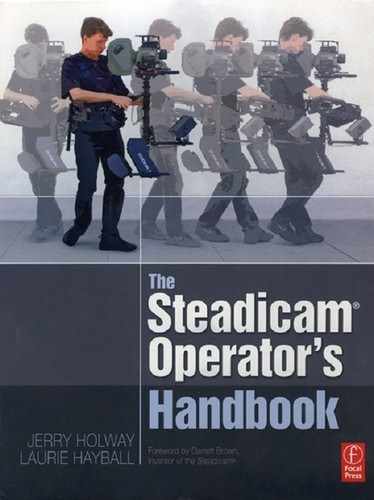Steadicam® and live TV
by Lars Riis
Sometimes the hardest part of being a Steadicam operator is figuring out how to be useful to production
As Steadicam became more common in movies, more and more IV poroducers saw a new way to spice up their studio productions. Often they had little idea how to put it to good use — they just loved what they saw in the movies. It was up to the operators to educate producers to a level where they would understand what to expect and what to ask for in Steadicam work.
Some advantages of having the Steadicam in the studio were not even visible in the program, like the fact that a Steadicam operator can disappear from the floor in a second or two, leavingthe floor open for other cameras. As a result, decorations could be built for 350° shooting, leaving a small area for cameras on pedestals, cranes, etc.
In Denmark in the mid-nineties, State of the Netion ran for 4 years as a weekly 45 minutelive-broadcast talk show, debating politics, moral issues, current events, etc. The set was an arena with four seat rows in a 300° circle. We would have around one hundred twenty spectators ami up to ten miked guests. In the center of the circle was an oval table where the host would stand at one end and four head guests Stood, two on each side of him. The idea was to have a verry intense debate, at the table or between tablc and audience, where many opinions could be tested.
This program demanded d highly flexible production setup, to allow for maximum freedom in the debate. We ended up shooting on just four cameras - one on a crane mainly used forintroloutro shots and for reactions from the audience, another camera on a pedestal, holding asafe shot of the entire table, and two Steadicams, one on each half of the arena.
It was decided that we would stay on the Steadicam if at all possible. Rather than cut to crane or pedestal, we wanted to have the geography sorted out as well as give the viewers a sense being in the middle of things. This meant that we at operators were all over the place, with just two rules: we only leave our half of the floor when we know we can return safely, and we sort out axis problems between us.
Axis problems rarely occur in i traditional studio design, but when the studio is 300 or more,you ask for trouble. These axis problems were easily solved with two Steadicams — we couldalways establish a new axis that only the Steadicams could work on and return when we felt the discussion was taking another direction — tally lit or not. Of course we had to listen very intensely to the debate and try to figure out who would react to this ami thai statement — add them to the frame if possible or offer the producer a reaction shot. ho add to the confusion the host might leave the table end sit with guests in the audience, thereby forcing us to have both rigs on the same side of the studio for a while. We had talked these situations through so the host knew which camera to address. This understanding gave him total freedom to take off when he wanted — we knew we could cover his actions, and the producer knew to give us the ball.
Most producers have worked with cameras on pedestals that don't change places — they often number them from left right in the studio, but with the Steadicam the producer had little idea where we were and das therefore unable to guide us. Often the best he could do was to suggest where the whole thing would go from here and leave the puzzle solving to us.
It takes a while before a producer is comfortable with that arrangement, end it takes a lot talking to make sure that you know exactly what he wants. After all it is still his show, and you as operator can easily take it in the wrong direction. On the ether hand, when all pieces fall into place the producer is all smiles, because he gets things that he was unable to plan forget everything right we are able to tell the story in a much more elegant way than that of just cutting to reaction and back.
Getting it right of course involves focus putting. In order to minimize the number of people on the floor, we had our pullers placed behind the pedestal camera with a monitor each, so they could see our framing, and decide who to keep in focus. We worked a lot on the long end of the lenses, so we could have interesting focus changes from audience to guest. Communication with the pullers was, as between operator, a matter of eyebrows and sign language.
It helped me a lot to have the same puller all the time, so I couldfeel confident that we understood each other without words. Withoutthat understanding we could not push the envelope for what waspossible in that studio. I have the deepest respect for those guys, It not far to place them far away with a monitor and only sometimes a mod angle at us — and still demand not just focus but even muni reading skills.
Of course we were relying on luck sometimes, but the more you prepare the luckier you get.

Lars Riis
